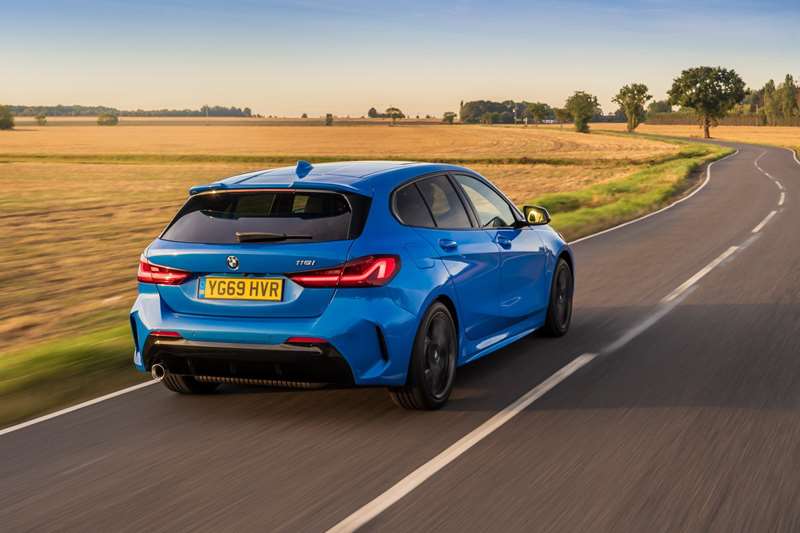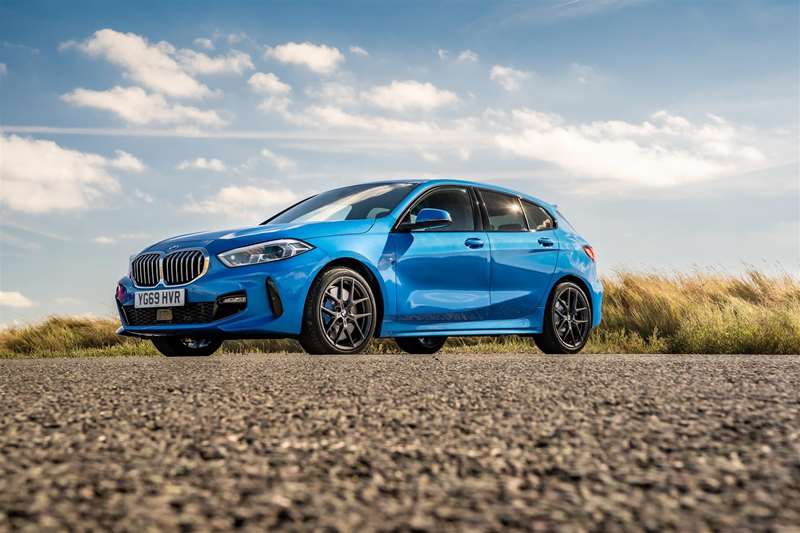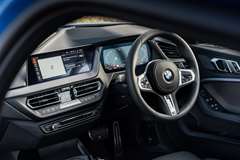What’s new?
The last holdout for rearwheel-drive among small prestige hatchbacks has finally transferred to the front-wheeldrive pack.
This new-generation machine is based on the same underpinnings used by the BMW X1 and X2, as well as the Mini Countryman.
A landmark changeover is likely to be good for the bottom line on two counts: manufacturing costs and complexity are reduced and the new layout might also appeal to newcomers to the brand who, if transferring from any rival’s offerings, will likely already be well used to frontwheel-drive.
What comes as standard?
The cloth seats might suggest cost restraint, but don’t get too upset. Austerity isaword that has a different meaning for BMW than it does with a mainstream brand: this isa premium player; rest assuredly you’re buying aparticularly polished small car.
The big reach is into the technology bin. The 118i M Sport runs to stuff you don’t commonly see in small cars — speed sign display, parking and reversing assist, wireless phone charging, rear camera and the snazzy Bluetoothdriven Apple CarPlay set-up that only BMW seems to have.
The reversing aid is more than a set of sonar beepers. It has ability to store the steering movements for any sectionthe car has just traversed at no more than 36kmh and then retracethat path in reverse, automatically, for up to 50m.
This model also takes a hefty swathe of the latest active and passive safety gear plus the ConnectedDrive setup that delivers concierge service. The tyre pressure monitors are nice to see and it also comes with emergency city braking as standard, along with aspeed limit display on the dashboard and lane departure warning.
It also comes with plenty of extra options, so prepare to torture the bank account.
What’s it like to look at?
The M Sport styling add-ons certainly improve the aesthetics, and fair dues to the designers. Shifting from a longitudinal to transverse powertrain layout demands additional width, yet they’ve done agreat job disguising this. Overall, the 118i M Sport remains true enough to the long bonnet, lean body look that has sustained through every previous generation.
What’s it like inside?
Gone are plain plastics. Everything you look at and interact with is palpably excellent.
The big iDrive 7.0 touchscreen is very simple to navigate despite its vast range of functionality. Most ingredients can be controlled in a number of different ways — via a rotary controller, touchscreen or voice control.
I still think Mercedes-Benz’s ‘‘digital plank’’ MBUX layout is better overall, but this is certainly deserving of a‘‘much improved’’ accolade.
Dimensional adjustments (shorter by 20mm, wider by 34mm, taller by 13mm) allow for improved in interior space. That’s most apparent in the rear. BMW says there’s 33mm more knee room, 19mm more headroom and 67mm width in the boot than the previous model. It could have been even better were the back seat not so heavily bolstered and it didn’t have a transmission tunnel (well, it isn’t, obviously, but it looks like one — and the question is: Why?).
The driving position is really good, low-down and with lots of adjustment. However,thick rear pillars and small rear windows mean over-theshoulder visibility is rather hampered, but that’s why it has blind spot sensors and such a competent reversing aid.
The boot is wider and offers a useful 380 litres with the back seats in place. There’s a handy underfloor compartment that’s worth making the most of because, with the floor in its usual position, the area is quite shallow — something I didn’t appreciate until the rear hatch came with millimetres of touching a barbecue gas bottle I put in there.
What’s it like to drive?
‘‘Sheer driving pleasure’’, the tagline BMW has sworn by for years, has also been understood by some to be a code for ‘‘rear-wheel-drive cars are more fun’’. Indeed, backin the days when rear-wheeldrive-cars were a staplefor the brand, it was quite snooty in eschewing front-wheel-drive as inferior.
It hasn’t wholly forgotten that mindset, but nowadays argues that, unlike 15 years ago, it’s challenging to tell the difference.
Fair call? Well, possibly, yet it’s really no challenge at all to determine what team it is now on. Any brisk getaway is a clear giveaway and, when pushing on, there’s a point where you can sense when the power feed is combating steering input. The torque effect is nothing major, but it’s there.
It retains a well-balanced feel and has all the electronic safety nets working with the samehigh level of quiet efficiency that made this car a standout in its redundant format. And it’s still fun.
Also worth notingis that higher powered versions will offer xDrive as an option, while the range-topping M135i hot hatch will come as 4WD only, albeit not quite like Quattro.
BMW’s system allows a maximum 50:50 front/rear power split, but in lower speeds or in dry conditions the front wheels do all of the work.
The 118i’s engine isthe three-cylinder shared with Mini (Cooper hatch and Countryman). I’ve enjoyed it more in those cars than this one and cannot quite put my finger on why.
After all, even though a 0-100kmh time of 8.5 seconds is more peppy that powerful, power-to-weight ratio is decent through much of the structure being made of aluminium and high-strength steel. And it sounds good, too.
Basically, the pleasure comes down to how it attacks corners. Pitting new against old would probably enforce that the previous car was no pushover; those rear-wheel drive chassis responses and turn-in precision make it a sweet drive that deserves celebration.
Still, even at entry level, you needn’t go far down a favourite road to be left thinking this new model is a slick reinterpretation of that traditionally sporty handling.
The focus on agility does have a down side in that you can expect to feel the road surface for much of the time. The M Sport’s 10mm suspension drop, 18-inch alloys, upgraded braking system and sharpened steering obviously help it to lift its game, though perhaps they also impact — quite literally — on how it tackles rippled coarse-chip.
In BMW-speak, ‘‘sporty’’ all too often comes at the expense of suppleness. In fairness, our coarse-chip roads are about the worst kind of sealed surface you can present to suspension engineers. There’s really nothing like it back in Europe. However, you have to imagine the tune here is also a contributor to abrittleness that can be atouch wearying.
Verdict
Yes, there's occasionally the nagging sensation that it would have been better with drive to the rear wheels, but there’s no turning back now and what you get is still something to celebrate.
There’s enough going on here to impress that BMW still delivers abetter driver’s car at base level than the alternate prestige competition.
- Richard Bosselman
Photos: BMW












